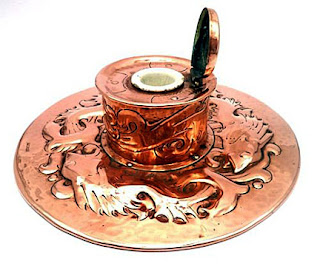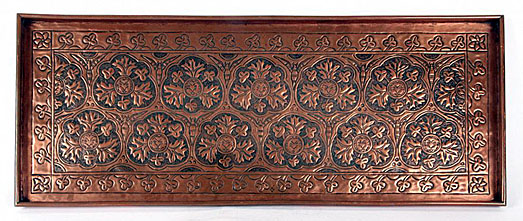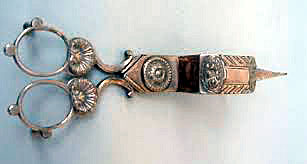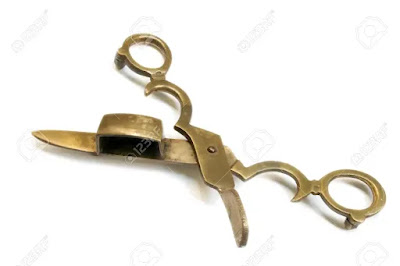 QUESTION: While browsing a recent antique show, I discovered a delightful little copper box with what looked like an embossed design. The dealer told me it was probably made around the turn of the 20th century or at least before World War I. She said the design was repoussé on copper. I’d like to know more about this repousse technique. Can you give me a bit of history and an explanation of how it’s done?
QUESTION: While browsing a recent antique show, I discovered a delightful little copper box with what looked like an embossed design. The dealer told me it was probably made around the turn of the 20th century or at least before World War I. She said the design was repoussé on copper. I’d like to know more about this repousse technique. Can you give me a bit of history and an explanation of how it’s done?
ANSWER: There are two techniques for hammering copper—chasing and repousse. The difference between the two is that chasing pushes the metal in from the front side while repousse pushes the metal out from the  backside. Both techniques frequently employ a backing to support the work material and confine the movement of the metal to the immediate area around the tool.
backside. Both techniques frequently employ a backing to support the work material and confine the movement of the metal to the immediate area around the tool.
While the word repoussé comes from the French word repoussage, meaning "pushed up," the word chasing, which also derives from the French word chasser, meaning ”to drive out.” Repousse is a metalworking technique in which an artisan shaped a malleable metal by hammering from the reverse side to create a design in low relief. Chasing is a similar technique in which the piece is hammered on the front side, sinking the metal. The two techniques are often used in conjunction. Many metals can be used for chasing and repoussé work, including gold, silver, copper, and alloys such as steel, bronze, and pewter. Tool marks are often intentionally left visible.
With the simplest technique, sheet gold could be pressed into designs carved in intaglio in stone, bone, metal or even materials such as jet. The gold could be worked into the designs with wood tools or, more commonly, by hammering a wax or lead "force" over it.
 Both techniques date from antiquity and have been used widely with gold and silver for fine detailed work, such as the burial mask of King Tutankhamun, and copper, tin, and bronze for larger sculptures, such as the Statue of Liberty. Both methods require only the simplest tools and materials, and yet allow great diversity of expression. They’re also more affordable, since there’s no loss or waste of metal, which mostly retains its original size and thickness.
Both techniques date from antiquity and have been used widely with gold and silver for fine detailed work, such as the burial mask of King Tutankhamun, and copper, tin, and bronze for larger sculptures, such as the Statue of Liberty. Both methods require only the simplest tools and materials, and yet allow great diversity of expression. They’re also more affordable, since there’s no loss or waste of metal, which mostly retains its original size and thickness.
 Before the use of repousse, ancient artisans pressed gold sheet into a die to work it over a design in cameo relief. Here the detail would be greater on the back of the final design, so some final chasing from the front was often carried out to sharpen the detail.
Before the use of repousse, ancient artisans pressed gold sheet into a die to work it over a design in cameo relief. Here the detail would be greater on the back of the final design, so some final chasing from the front was often carried out to sharpen the detail.
In 1400 BCE, ancient Egyptians used resin and mud as a softer backing for repoussé. The use of patterned punches dates back to the first half of the 2nd millennium BCE Craftsman made the simplest patterned punches using loops or scrolls of wire.
By 400 BCE., the ancient Greeks had begun using a combination of punches and dies on a beeswax backing to produce repousse on their bronze armor plates.
 The resurgence of repousse and chasing first occurred in England during the late 19th century as part of the British Arts & Crafts Movement. Most notably was the work produced at the Keswick School of Industrial Arts, founded in 1884 by Canon Hardwicke and his wife, Edith Rawnsley, as an evening class in woodwork and repoussé metalwork at the Crosthwaite Parish Rooms, in Keswick, Cumbria. Hardwicke designed the curriculum to alleviate unemployment. The school prospered, and within 10 years more than 100 men had attended classes.
The resurgence of repousse and chasing first occurred in England during the late 19th century as part of the British Arts & Crafts Movement. Most notably was the work produced at the Keswick School of Industrial Arts, founded in 1884 by Canon Hardwicke and his wife, Edith Rawnsley, as an evening class in woodwork and repoussé metalwork at the Crosthwaite Parish Rooms, in Keswick, Cumbria. Hardwicke designed the curriculum to alleviate unemployment. The school prospered, and within 10 years more than 100 men had attended classes.
 The school prospered and swiftly developed a reputation for high quality copper and silver decorative metalwork. By 1888 nearly 70 men were attending the classes. By 1890 the school was exhibiting nationally and winning prizes; Its students numbering over 100, it had outgrown its cramped home in the parish rooms, forcing Rawnsley to raise funds for a purpose-built school nearby.
The school prospered and swiftly developed a reputation for high quality copper and silver decorative metalwork. By 1888 nearly 70 men were attending the classes. By 1890 the school was exhibiting nationally and winning prizes; Its students numbering over 100, it had outgrown its cramped home in the parish rooms, forcing Rawnsley to raise funds for a purpose-built school nearby.
 The Newlyn Industrial Class, later renamed the Newlyn Art Metal Industry, established in 1890 by John D. Mackensie, was similar to Keswick and shared a common purpose with it. Inspired by the teachings of John Ruskin, they aimed to provide a source of employment in small communities where work came and went with the seasons. At the Newlyn classes, held in a net loft above a fish-curing yard, the pupils were mainly fishermen, while at Keswick students were pencil makers, laborers, gardeners, shepherds, and tailors.
The Newlyn Industrial Class, later renamed the Newlyn Art Metal Industry, established in 1890 by John D. Mackensie, was similar to Keswick and shared a common purpose with it. Inspired by the teachings of John Ruskin, they aimed to provide a source of employment in small communities where work came and went with the seasons. At the Newlyn classes, held in a net loft above a fish-curing yard, the pupils were mainly fishermen, while at Keswick students were pencil makers, laborers, gardeners, shepherds, and tailors.
Both metal workshops specialized in the production of repoussé copper work, This technique and material was popular with amateur craftsmen and women across the country because it was easy to learn. A student placed a flat piece of copper face down on a bed of pitch, or, as in the Newlyn workshops, lead. These materials were chosen because they would yield to the force of the blows of the punch but would still support the metal. Once a student had punched the design out from the reverse, he or she turned the metal over and chased finer details on the front.
To read more articles on antiques, please visit the Antiques Articles section of my Web site. And to stay up to the minute on antiques and collectibles, please join the over 30,000 readers by following my free online magazine, #TheAntiquesAlmanac. Learn more about "The Age of Photography" in the 2023 Holiday Edition, online now. And to read daily posts about unique objects from the past and their histories, like the #Antiques and More Collection on Facebook.











































